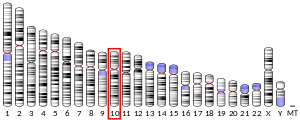PCDH15
Protocadherin-15 is a protein that in humans is encoded by the PCDH15 gene.[5][6][7]
Function
This gene is a member of the cadherin superfamily. Family members encode integral membrane proteins that mediate calcium-dependent cell-cell adhesion. The protein product of this gene consists of a signal peptide, 11 extracellular calcium-binding domains, a transmembrane domain and a unique cytoplasmic domain. It plays an essential role in maintenance of normal retinal and cochlear function.[7] It is thought to interact with CDH23 to form tip-link filaments.[8]
Clinical significance
Mutations in this gene have been associated with hearing loss, which is consistent with its location at the Usher syndrome type 1F (USH1F) critical region on chromosome 10.[7] Variation within it has also been found to be associated with normal differences in human facial appearance.[9]
References
- GRCh38: Ensembl release 89: ENSG00000150275 - Ensembl, May 2017
- GRCm38: Ensembl release 89: ENSMUSG00000052613 - Ensembl, May 2017
- "Human PubMed Reference:". National Center for Biotechnology Information, U.S. National Library of Medicine.
- "Mouse PubMed Reference:". National Center for Biotechnology Information, U.S. National Library of Medicine.
- Ahmed ZM, Riazuddin S, Bernstein SL, Ahmed Z, Khan S, Griffith AJ, Morell RJ, Friedman TB, Riazuddin S, Wilcox ER (Jun 2001). "Mutations of the protocadherin gene PCDH15 cause Usher syndrome type 1F". Am J Hum Genet. 69 (1): 25–34. doi:10.1086/321277. PMC 1226045. PMID 11398101.
- Ahmed ZM, Riazuddin S, Ahmad J, Bernstein SL, Guo Y, Sabar MF, Sieving P, Riazuddin S, Griffith AJ, Friedman TB, Belyantseva IA, Wilcox ER (Dec 2003). "PCDH15 is expressed in the neurosensory epithelium of the eye and ear and mutant alleles are responsible for both USH1F and DFNB23". Hum Mol Genet. 12 (24): 3215–23. doi:10.1093/hmg/ddg358. PMID 14570705.
- "Entrez Gene: PCDH15 protocadherin 15".
- Kazmierczak, Piotr; Sakaguchi, Hirofumi; Tokita, Joshua; Wilson-Kubalek, Elizabeth M.; Milligan, Ronald A.; Müller, Ulrich; Kachar, Bechara (2007). "Cadherin 23 and protocadherin 15 interact to form tip-link filaments in sensory hair cells". Nature. 449 (7158): 87–91. doi:10.1038/nature06091. PMID 17805295.
- http://www.pnas.org/content/115/4/E676.short
Further reading
- Alagramam KN, Murcia CL, Kwon HY, et al. (2001). "The mouse Ames waltzer hearing-loss mutant is caused by mutation of Pcdh15, a novel protocadherin gene". Nat. Genet. 27 (1): 99–102. doi:10.1038/83837. PMID 11138007.
- Alagramam KN, Yuan H, Kuehn MH, et al. (2001). "Mutations in the novel protocadherin PCDH15 cause Usher syndrome type 1F". Hum. Mol. Genet. 10 (16): 1709–18. doi:10.1093/hmg/10.16.1709. PMID 11487575.
- Ben-Yosef T, Ness SL, Madeo AC, et al. (2003). "A mutation of PCDH15 among Ashkenazi Jews with the type 1 Usher syndrome". N. Engl. J. Med. 348 (17): 1664–70. doi:10.1056/NEJMoa021502. PMID 12711741.
- Zheng QY, Yan D, Ouyang XM, et al. (2005). "Digenic inheritance of deafness caused by mutations in genes encoding cadherin 23 and protocadherin 15 in mice and humans". Hum. Mol. Genet. 14 (1): 103–11. doi:10.1093/hmg/ddi010. PMC 2858222. PMID 15537665.
- Ouyang XM, Yan D, Du LL, et al. (2005). "Characterization of Usher syndrome type I gene mutations in an Usher syndrome patient population". Hum. Genet. 116 (4): 292–9. doi:10.1007/s00439-004-1227-2. PMID 15660226.
- Roux AF, Faugère V, Le Guédard S, et al. (2007). "Survey of the frequency of USH1 gene mutations in a cohort of Usher patients shows the importance of cadherin 23 and protocadherin 15 genes and establishes a detection rate of above 90%". J. Med. Genet. 43 (9): 763–8. doi:10.1136/jmg.2006.041954. PMC 2564578. PMID 16679490.
- Zheng QY, Yu H, Washington JL, et al. (2007). "A new spontaneous mutation in the mouse protocadherin 15 gene". Hear. Res. 219 (1–2): 110–20. doi:10.1016/j.heares.2006.06.010. PMC 2855306. PMID 16887306.
- Le Guédard S, Faugère V, Malcolm S, et al. (2007). "Large genomic rearrangements within the PCDH15 gene are a significant cause of USH1F syndrome". Mol. Vis. 13: 102–7. PMC 2533038. PMID 17277737.
External links
- GeneReviews/NCBI/NIH/UW entry on Usher Syndrome Type I
- PDBe-KB provides an overview of all the structure information available in the PDB for Human Protocadherin-15 (PCDH15)



